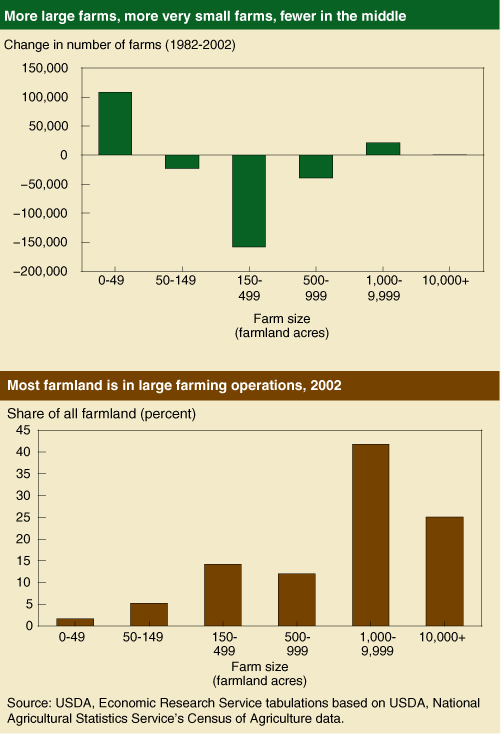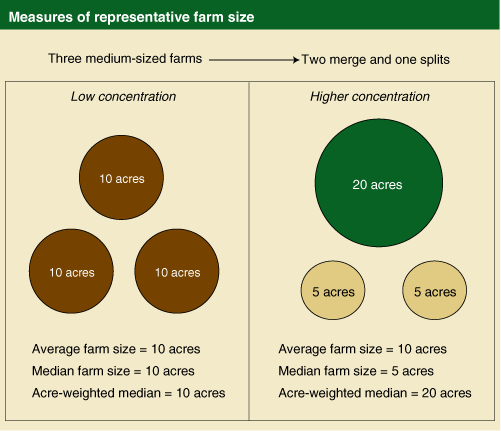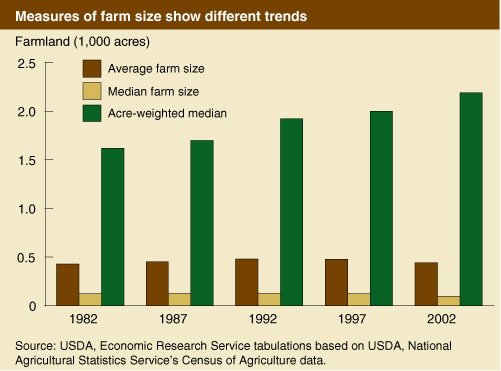Data Feature
- by Nigel Key and Michael J. Roberts
- 11/1/2007
Measures of Trends in Farm Size Tell Differing Stories
The total amount of land used for farming has been relativelystable for several decades, but this stability masks significantchanges in the structure of agriculture. Since 1982, the number oflarge farms and very small farms has increased, while the numberof small to midsized farms has declined. The changing size distributionof farms makes it difficult to capture the trends in a simplemeasure, such as the average or median farm size. A sizemeasure that reflects both the increasing concentration of productionon large farms and the growth in the number of smallfarms can provide insight into the structural changes occurring inU.S. agriculture.
Farmland Has Become Concentrated on Larger Farms
In recent decades, agricultural land has become concentratedon larger operations—the number of farms with more than1,000 acres increased by 14 percent between 1982 and 2002.Farms with 50-1,000 acres declined by about 17 percent, whilethe number of farms with fewer than 50 acres increased byroughly the same percentage.
Small farms, however, account for only a very small share oftotal farmland. Farms with fewer than 50 acres operated lessthan 2 percent of all farmland in 2002, while farms with morethan 1,000 acres operated two-thirds of all farmland.
Traditional Size Measures Mask Concentration Change
Because most farms are small but most production occurson large farms, common measures of representative farmsize—the average and median—obscure large changes in theconcentration of production. Average and median measures offarm size focus on the typical farm, which is small, rather thanthe typical acre of farmland, which is associated with a largeroperation.
Consider the example of three hypothetical farms, eachwith 10 acres. Suppose two consolidate to make a farm doublein size and one farm is split into two smaller operations. Beforeand after the change, the number of farms, total amount ofland, and average farm size remain the same. The median farmsize—the farm for which half are smaller and half are larger—declines from 10 acres to 5 acres. Changes in the average andmedian farm size seem to belie the rather large increase in landconcentration—a single farm now accounts for two-thirds ofthe land.
An alternative measure—the acre-weighted median—betterreflects the size of operations where most productionoccurs. The acre-weighted median is calculated by orderingfarms from smallest to largest and picking the farm size at themiddle acre (the standard median focuses on the middle farm).Half of all land is on farms smaller than the acre-weightedmedian, and half of land is on bigger farms. In the three-farmexample, two-thirds of the acres are on a 20-acre farm andone-third of the acres are on farms with 5 acres, so the acreweightedmedian is 20 acres.
New Measure Tells a Different Story
This simple three-farm example is similar to what has actuallyoccurred in U.S. agriculture, and the three size measures—average, median, and acre-weighted median—suggest differenttrends over time. Because the total amount of farmland and thenumber of farms have remained stable since 1982, average farmsize has also remained stable. Average farm size was 441 acres in2002, and ranged between 430 and 480 acres in the previous 20-year period. In contrast, the median farm size in 2002 of 95 acresrepresents a 20-percent decrease over the period, largely reflectingthe growing number of very small farms.
On the other hand, the acre-weighted median increased byabout 35 percent since 1982, reflecting continued shifts of landto bigger operations. In 2002, the acre-weighted median was2,190 acres—half of all farmland was on farms that were largerthan that size.
This article is drawn from:
- Farmland and Cropland Concentration Measures. (2007). Economic Research Service.




